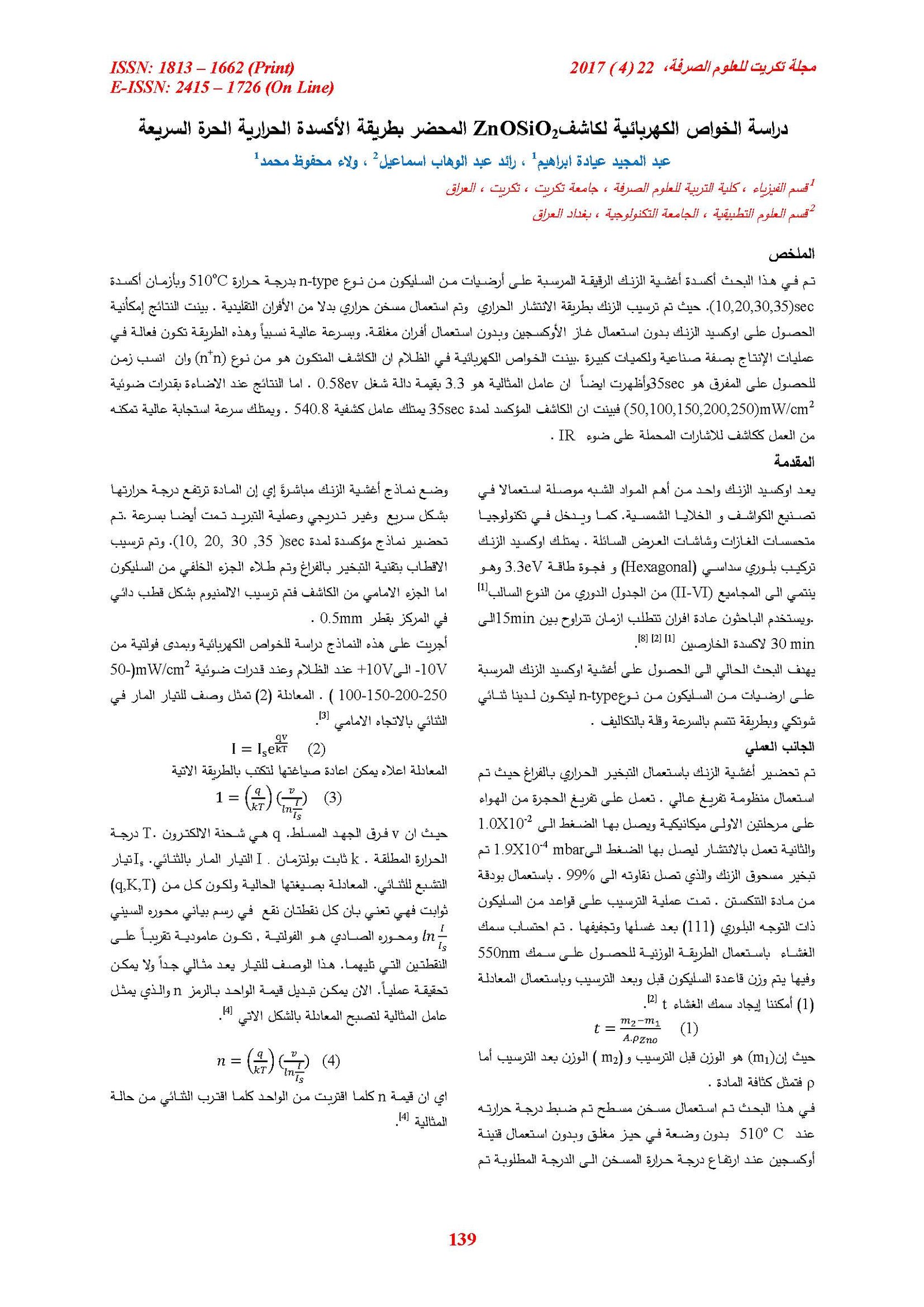Study the electrical properties of ZnOSiO2 detector prepared by free rappid thermal oxidation
Main Article Content
Abstract
Zinc thin films deposited on (n-type)silicon at 510o C with oxidation times (10,20,30,35) sec have been oxidized. Zinc have been deposited by thermal diffusion method using heater instead of conventional furnace .It is found that we can get zinc oxide with outoxegen and closed farneces rapidly. The electrical properties in dark show that the detector is shottky diode, and the best time to obtain the detector is 35 sec, and the ideality factor is 3.3 with a work function of 0.58 ev. It is found that the resalts at light power (50,100,150,200,250) mw/cm2.Show that the detector oxidiced in 35 sec have detectivity factor 540.8 and have a high responsivity which enable the detector to detect the IR signals.
Article Details

This work is licensed under a Creative Commons Attribution 4.0 International License.
Tikrit Journal of Pure Science is licensed under the Creative Commons Attribution 4.0 International License, which allows users to copy, create extracts, abstracts, and new works from the article, alter and revise the article, and make commercial use of the article (including reuse and/or resale of the article by commercial entities), provided the user gives appropriate credit (with a link to the formal publication through the relevant DOI), provides a link to the license, indicates if changes were made, and the licensor is not represented as endorsing the use made of the work. The authors hold the copyright for their published work on the Tikrit J. Pure Sci. website, while Tikrit J. Pure Sci. is responsible for appreciate citation of their work, which is released under CC-BY-4.0, enabling the unrestricted use, distribution, and reproduction of an article in any medium, provided that the original work is properly cited.
References
1- S.M. Sze, “Semiconductor Devices Physics and Technology” Translated to Arabic by F.G. Hayaly, H.A. Ahmed, Baghdad, (1990).
2- C. Jagadish, S. Pearton, "Zinc Oxide Bulk, Thin Films and Nanostructures", Elsevier Limited, (2006).
3- H. L. Tsaia, W. C. Lia, M. J. Chena, M. Shiojirib, J. R. Yang a, The structure and ultraviolet electroluminescence of n – ZnO – SiO2 –ZnOnanocomposite/ p -GaNheterojunction LED.ECS Transactions, 33 (2) 267-275 (2010)
4- Zhaia Jing, Taoa Xia, Pua Yuan, Zenga Xiao-Fei, ChenbJian - Feng, Core-shell structured ZnO/SiO2 nanoparticles: Preparation, characterization and photocatalytic property, Applied Surface Science, 257, 393–397 (2010)
5- A.G. Milnes & D.L. Feucht, “Heterojunctions and Matal-Semiconductor junction”, Academic Press, London, (1972).
6- Synthesis and Characterization of ZnO/SiO2 Core-Shell Microparticles and Photolytic Studies in Methylene Blue .Ali İmran Vaizoğullar, Ahmet Balcı International Journal of Research in Chemistry and Environment Vol. 4 Issue 2 April (161-165) (2014).
7- C. X. Xu, X. W. Sun, B. J. Chen, "Field emission from gallium-doped zinc oxide nanofiber array", Applied Physics Letters, 84, (2004)
